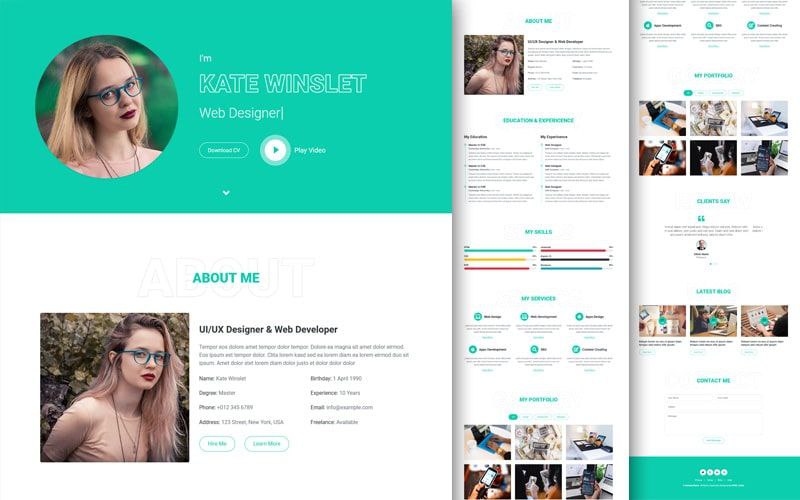A professional freelance portfolio is important if you’re a freelancer looking for freelance recruiters and elevate your online presence and attract potential clients. Your portfolio serves as a visual representation of your skills, experience, and style. It is the first impression potential clients will have of you, which can make or break your chances of getting hired. In this blog post, we will unlock the secret to creating a stunning freelancing portfolio and show you how to create a professional freelance portfolio that will set you apart from the competition.
Understanding the Importance of a Freelancing Portfolio
In the competitive world of freelancing, having a standout portfolio is not just an option; it’s a necessity. Your portfolio visually represents your skills, experience, and style. It is a powerful tool that can make or break your chances of landing new clients.
Imagine you’re a potential client looking to hire a freelancer. You stumble upon a website with a mediocre portfolio featuring blurry images and poorly written descriptions. What would be your impression of that freelancer? Most likely, you would question their professionalism and competence.
On the other hand, picture yourself coming across a portfolio that showcases stunning visuals, a clear display of skills, and well-crafted project descriptions. You would be instantly captivated by the freelancer’s talent and dedication to their craft.
A strong portfolio sets you apart from the competition and positions you as an expert. It allows potential clients to envision working with you and gives them confidence in your ability to deliver exceptional results. Your portfolio is your opportunity to make a great first impression and stand out in a crowded marketplace. So, investing time and effort into creating a professional and compelling portfolio that accurately represents your unique abilities is essential.
Steps to Building an Attractive and Professional Freelance Portfolio to Attract Freelance Recruiters
Creating a professional freelancing portfolio requires careful planning and attention to detail. Follow these steps to build an attractive and professional portfolio that will impress potential clients:
- Define your goals: Before you start building your portfolio, take some time to define your goals. What kind of clients do you want to attract? What sort of work do you want to showcase? Clearly defining your goals can tailor your portfolio to target your desired audience.
- Choose your best work: The most substantial projects represent your skills and expertise. Quality over quantity is essential here. Be strategic in your choices and only include work that aligns with your target clients’ needs.
- Organize and structure your portfolio: Create a logical, easy-to-navigate structure. Consider categorizing your work by type, industry, or client. Make sure your portfolio is visually appealing and user-friendly.
- Craft compelling project descriptions: Each project in your portfolio should have a well-written and concise description highlighting your role, the challenges you faced, and the results you achieved. Use clear and persuasive language to demonstrate your expertise.
- Include client testimonials: Testimonials are powerful social proof that can boost your credibility. Ask satisfied clients for testimonials and showcase them prominently in your portfolio.
- Show your process: Consider including case studies or behind-the-scenes content to showcase your creative process. This can give potential clients insight into your work and what makes you unique.
Remember, your freelancing portfolio is a living document that should be regularly updated. Continually evaluate and refresh your portfolio to keep it relevant and compelling. With a well-crafted and professional portfolio, you’ll be one step closer to attracting the clients of your dreams.
Top Elements to Include in Your Freelance Portfolio
When it comes to creating a professional freelancing portfolio, there are a few key elements that can make all the difference. Including these elements will showcase your skills and expertise and help you stand out from the competition.
First, you must include a compelling bio or about section. This is your opportunity to introduce yourself to potential clients and highlight your experience and qualifications. Remember to mention any relevant certifications, degrees, or awards you have earned.
Next, make sure to include a variety of work samples. Showcasing a range of projects will demonstrate your versatility and expertise in different areas. Include your best work and ensure each sample is accompanied by a clear description of your role and the skills utilized.
How to write a perfect freelancing profile portfolio description?
Remember to include a contact section with your email address and other relevant contact information. Make it easy for potential clients to reach out to you.
Lastly, consider including a section highlighting additional services you offer, such as graphic design, copywriting, or social media management. This will show potential clients that you are a well-rounded freelancer who can provide a wide range of services.
By including these top elements in your freelancing portfolio, you will be well on your way to impressing potential clients and landing the freelance gigs of your dreams.
How to Showcase Your Work Effectively to Attract Freelance Recruiters
Your portfolio reflects your skills and expertise, so it’s important to showcase your work effectively to capture the attention of potential clients. Here are some tips to help you showcase your work in the best possible way:
- Choose high-quality images: Ensure that the photos in your portfolio are high-resolution and visually appealing. Poor quality or blurry images can give the impression of unprofessionalism and may turn off potential clients.
- Show various work: Include diverse projects to demonstrate your versatility and expertise. This can help potential clients see that you can handle different types of projects and meet their specific needs.
- Create engaging project descriptions: Include a list of projects with context. Craft interesting descriptions that explain the project’s objectives, your role, and the results achieved. Use storytelling techniques to make your descriptions compelling and memorable.
- Use a clean and organized layout: Make sure your portfolio is easy to navigate and visually appealing. Use a clean and organized layout that allows potential clients to find the information they need quickly. Consider using categories or tags to help organize your work.
- Highlight your best projects: While showing various works is essential, highlight your best projects prominently. These should be the projects that best showcase your skills and expertise and align with the needs of your target clients.
By following these tips, you can effectively showcase your work and make a lasting impression on potential clients. Remember to regularly update your portfolio to reflect your latest and best work.
Keeping your Freelance Portfolio Updated and Relevant will Attract Freelance Recruiters
Once you have created a professional freelancing portfolio, it’s crucial to keep it updated and relevant. This shows potential clients you are active in your field and continually improving your skills. Here are some tips for keeping your portfolio fresh:
- Regularly update your projects: Add them to your portfolio as you complete new projects. This ensures potential clients see your recent work and understand your evolving skills.
- Remove outdated work: As your portfolio grows, removing older projects that may no longer accurately represent your current abilities is important. Keeping your portfolio streamlined and focused on your best and most recent work is essential.
- Stay updated with industry trends: The freelancing world constantly evolves, and staying on top of the latest industry trends is important. Incorporate new technologies, design styles, or techniques into your portfolio to show potential clients that you are up-to-date and relevant.
- Seek feedback and make improvements: Be bold and ask for feedback from colleagues or mentors. Take their suggestions on board and make improvements to your portfolio as needed. Continuous improvement is key to staying ahead in the freelancing game.
Regularly updating and refining your portfolio demonstrates to potential clients that you are committed to delivering high-quality work and are actively engaged in your profession. This will increase your chances of attracting the clients of your dreams and elevating your freelancing career.
Final thought
In the fast-paced and competitive world of freelancing and to get freelance recruiters, your portfolio is your ticket to success. It’s not enough to have a portfolio; it must be outstanding. A well-crafted and professional freelancing portfolio sets you apart from the crowd and captivates potential clients. It showcases your skills, experience, and style in a way that makes clients eager to work with you.
However, creating a stunning freelancing portfolio is not a one-time task. It requires continuous effort and attention to detail. Regularly updating your portfolio with your best and most recent work ensures that you stay relevant and continue to impress potential clients. Seeking feedback and making improvements keeps your portfolio fresh and helps you stay ahead.
Remember, your portfolio is a reflection of you as a freelancer. It’s a visual representation of your expertise and professionalism. So, take the time to build a portfolio that accurately represents your unique abilities and showcases your best work. By following the steps and tips outlined in this blog post, you’ll be well on your way to creating a professional freelancing portfolio that attracts the clients of your dreams. Happy freelancing!






